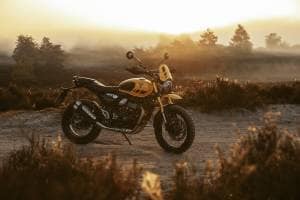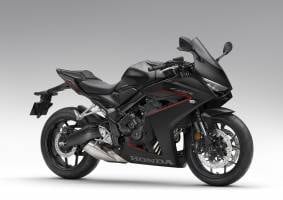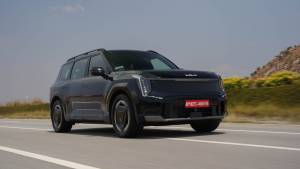Welcome to the brave new world of Hyundai where flowing streams in Switzerland, shapely rocks in the Arizona desert and weirdly shaped branches of African trees end up influencing car design. Bizarre as it might sound but that's the presentation that we sat through at the new Verna's international press launch in Dubai as designers tried to relate the meandering path of a river to character lines running across the length of the car while explaining what 'fluidic sculpture' stands for.
This is of interest to no one. What is of interest is all this newfound design mojo has transformed the Verna from the proverbial duckling into a swan. Hyundais were never great looking cars sensible, practical and great value but never good looking and the Verna was the biggest offender of them all. The original Verna was dull, bulbous and plain odd to look at. Last year's Verna Transform then exaggerated it all to the point where you couldn't look at it without wincing. And now all that gets consigned to the history bin.
The Sonata launched in international markets in late 2009 (one generation ahead of the car we have in India) was the first to employ this 'fluidic sculpture' language to great effect and has now evolved into a cohesive design language employed across the Hyundai range. This includes not just the big sedans but also SUVs and even small hatchbacks (the nose of the face-lifted i10 being a good example) and has built a strong brand identity for Hyundai, in line with what more mature European manufacturers like Audi and BMW have done. With the Verna almost the entire range has been fluidified with only the Santa Fe and i20 left (which means a face-lift for the latter is only a matter of time).
The new Verna breaks away from the usual three-box design and presents a more coupe-like profile bravely dubbed 'sleek on dynamic'. Wordplay aside it makes the Verna look handsome and allied to the upwardly riding shoulder line and narrowing glass house lends a sporty look to the profile. There's even an integrated boot-lid spoiler and chrome-tipped twin-exhausts to highlight that new found dynamism. It's the front though that screams with intent, the now trademark hexagonal grilled flanked by swept back headlamps with rather elaborate graphics (dubbed two-tone bezel) and relatively large L-shaped fog lamps which fit neatly at the extremities of the bumper. Hyundai's designers stress on how the Verna was designed to have a low and wide appearance and this is the first thing you notice with the car sitting smartly on its wheels and there being a latent dynamism even when stationary. And mercifully they have stopped short of over-adorning the car with lines, creases and angles and the result is a handsome, well proportioned and sporty sedan.
Five years of development and `900 crore have gone into the development of the new Verna (codenamed the RB) which was first presented to the world at the Moscow Motor Show. It carries the Solaris badge in Russia that was picked from 20,000 submissions in a contest to name the first vehicle to be produced there but it is known as the Accent worldwide and Verna in India (because there are no plans to discontinue the decade-old Accent).
It is built on an all-new platform which uses high-tensile strength steel for 58.6 per cent of the floor and chassis. This offers enhanced crash performance as well as reducing weight. Wheelbase is 70mm longer than the outgoing version and at 2570mm it is 20mm more than the City and 18mm more than the Vento. Overall length is up by 90mm and it is 5mm wider which translates into more space for the occupants and Hyundai claims the legroom to be on par with some of the higher segment cars. It certainly feels more spacious than any current C-segment car but we will have to wait for a detailed road test to find out exactly how much more space the Verna offers over its rivals. The height is now reduced by 13mm to give it that low, sporty stance while tyre sizes range from 14 all the way up to 16 inches.
Hyundai will raise the bar as far as safety goes by offering anti-lock brakes as standard on all variants in India (currently the City is the only car with standard ABS) and a full complement of six airbags will be on the options list. Suspension is via fully independent MacPherson struts up front and torsion beam at the rear which is tuned to improve handling and responsiveness while not compromising on the ride quality. Our test drive in Dubai gave us precious little opportunity to test the handling but around the few roundabouts it did feel far more planted and eager than the softly sprung dynamics we are used to. The interiors speak volumes about quality and good workmanship. I couldn't spot any issues with the fit and finish and it feels up-market and far roomier than before. The seating space at the front is ample for even those who are well over six feet tall and adequate space is available at the rear too. The seats are well contoured and offer good support at all the crucial points. The layout of the dashboard is synonymous with the fluidic sculpture design philosophy and all switches and the knobs are intuitive and well placed. The 'Y' shaped dashboard on the car we drove had a two-tone finish in black and silver but Indian cars are slated to receive a two-tone beige interior which we all seem to love so much.
The Verna will also have a very India-specific features list which won't be seen on the international models. This includes a cluster ioniser to purify the air inside the cabin, rear seat armrest, twin muffler tips, wood grain finished panels, electrically folding wing mirrors with indicators, chrome ringed air-con vents and a rear audio remote control to name a few. It will also have optional parking sensors and a camera with display in the rear-view mirror. Other features in the new Verna include a USB port on the front console for iPod, MP3 player or other portable multimedia device as well as an integrated Bluetooth system to hook up the mobile phone. This even supports A2DP (Advanced Audio Distribution Profile) so you can stream audio from your phone to the car's speakers.
The best for the last the massive engine range. There will be four powerplants: 1.4-litre and 1.6-litre Gamma petrols and 1.4-litre and 1.6-litre U-II diesels. The 1.4 petrol develops 108PS at 6300rpm and 135Nm of torque at 5000rpm while the 1.6-litre churns out 123PS at 6300rpm and 154Nm of torque at 4200rpm. That should make the Verna among the fastest cars in this segment with a 0-100kmph time in the low 10s. Five-speed manual and a 4-speed automatic (from the i20 automatic) will be offered with the petrol engines.
The 1.4-litre diesel produces 90PS at 4000rpm and 220Nm of peak torque at a low 1750-2750rpm while the 1.6-litre diesel produces 128PS at 4000rpm and massive 259Nm of peak torque at 1900-2750rpm. The diesels will be available with a 6-speed manual or a 4-speed automatic and again should be among the fastest cars in this segment. Come to think of it one of the strengths of the Verna is set to be powerful engines.
A Hyundai being bought for its rubber burning abilities? A Hyundai being the most stylish car in its segment? The new Verna is all set to turn accepted wisdom on its head.













